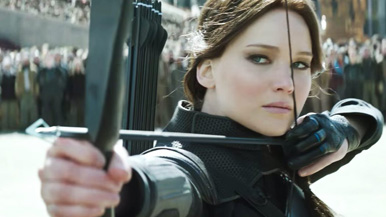Book vs. Movie - The Hunger Games: Mockingjay Part 2
By Ben Gruchow
November 28, 2016
The flat, displaced perspective that reads in one way during passages of urban warfare reads as far less cathartic in passages intended to address a traumatic state of mind. The book and series do ultimately close on a strong note, mostly because the narrative choice once again fits the situation (from an unspecified point in the future, Katniss ruminates on the lasting damage of both the Games and the war, on the nation and on herself).
The Movie
In light of that conclusion, it is immediately obvious upon watching the film that director Francis Lawrence’s primary concern with Mockingjay Part 2 - probably with both parts - was sticking the landing. Almost as important, by the result, was streamlining the narrative and making each of the plot points funnel into the final act in a way that was cinematically legible. There are two major changes the filmmakers made to the material in adaptation and a handful of minor ones in between those two; thankfully, we can more or less address these in order.
Major Change #1: The sizable chunk of narrative involving Peeta’s slow climb toward lucidity is whittled down to a single tense conversation between him and Katniss, one that leaves her single-mindedly bent on killing President Snow. The segment taking Katniss and Johanna through military and weapons training is excised entirely, replaced with a spur-of-the-moment plan for Katniss to stow away in one of the hovercraft as it delivers supplies to the troops on the front lines. Johanna gives her the intelligence that lets her do this.
Minor Change #1: In the novel, there are a couple of off-the-cuff deaths in the Star Squad as they initially breach the city, due to errant pods. These are remarked upon, but only in the past tense, and it’s the type of action that works only on the page and wouldn’t work at all tonally with the pace of the film, where the Star Squad stays intact until the triggering of the landmine.
Minor Change #2: It’s made more explicit in the film that Snow is tracking the Squad’s progress; we see him monitor them as they move into the sewers, and it’s clear that he specifically triggers the lizard muttations*. This is in keeping with the broadening of perspective that we’ve seen in the cinematic incarnation of this series so far.
Minor Change #3: The lizard-muttation sequence itself - and its follow-up through a disintegrating subway station - reminds me a little bit of the Bridge of Khazad-Dum sequence in The Fellowship of the Ring, in that a passage equating to a couple hundred sedate words on the page translate to perhaps the flagship action sequence of the entire film. This one, though, with its explosive kick-start, nightmarish fire-lit imagery, gunfire, and shrieking score, may take the prize as the standout action set piece of the entire franchise. It’s a minor change in the context of plot, but it’s a massive one in the context of pure incident.
Major Change #2: The final assault on the Capitol is simplified and accelerated. Instead of the city-block pod, we have a visually straightforward and arguably more realistic kamikaze charge, amid a firefight, in a straight line from a crowded street to the gates of Snow’s mansion. This takes place over four clearly delineated fronts: Katniss and Gale running toward the mansion, District 13 rebels advancing (they start the firefight in both mediums), Peacekeepers pushing back, and unarmed Capitol citizens caught in the middle.
Continued:
1
2
3
4
5




